 Royal Navy – 10 ships converted, service 1951-1967
Royal Navy – 10 ships converted, service 1951-1967HMS Orwell, Paladin, Petard, Teazer, Tenacious, Termagant, Terpsichore, Tumult, Tuscan, Tyrian
The early cold war saw a new threat emerging, the rise of a formidable submarine fleet by USSR, the Project 613 or Whiskey-class submarine. Derived from the late war revolurionary German Type XXI, they imposed a complete new type of frigate as all previous legacy WW2 models (River/Loch/Bay class) were now nearly obsolete. The new government however had a very limited budget for new built destroyers, and caught between too few of these and converting existing WW2 destroyers for this, making it in numbers, the choice was quick. 23 anti-submarine frigates from the now obsolete 1942 standard War Emergency Programme “utility” design were selected. The Type 15 were full conversions, but were found too costly to convert and the remaining, called Type 16 or “Tenacious” from the lead ship, were more austere conversions. Ten were converted as such. They were the last of these conversions, staying active until 1962-67.
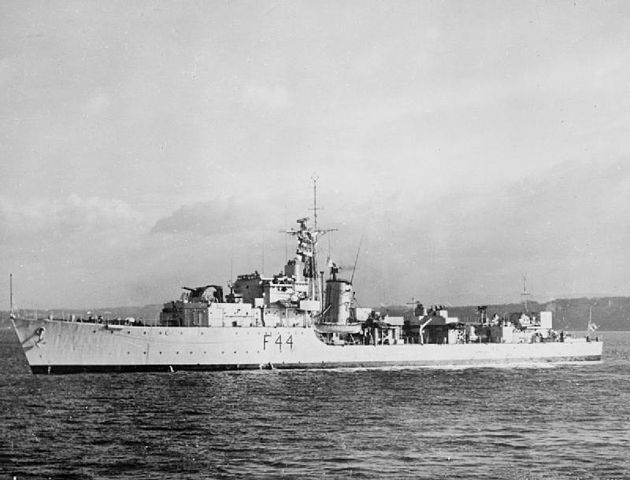
HMS Tenacious at anchor after conversion, 1952.
Design Development
The cost of the Type 16 “full” conversion led the admiralty to consider a cheaper conversion called Type 16 “limited” by contrast. They derived from O, P and T class ships caracterized by their four single main guns and two quad TTs, completed in 1943-44. That new conversion could be accomplished quickly as the hull and superstructures would be kept mostly unchanged, instead of razed and rebuilt on the Type 16. The new armament and an equally sensors suite making the bulk of these changes. The whole original artillery was removed, but they retained a quadruple TT, had a twin 4-in/45 Mark 19 DP gun forward instead, and two Squid Mark 3 plus 40 mm Bofors AA guns. Their main advantage was to be more stable (less roll) due to the lighter armament, also putting less strain on their powerplant, which was also unchanged.
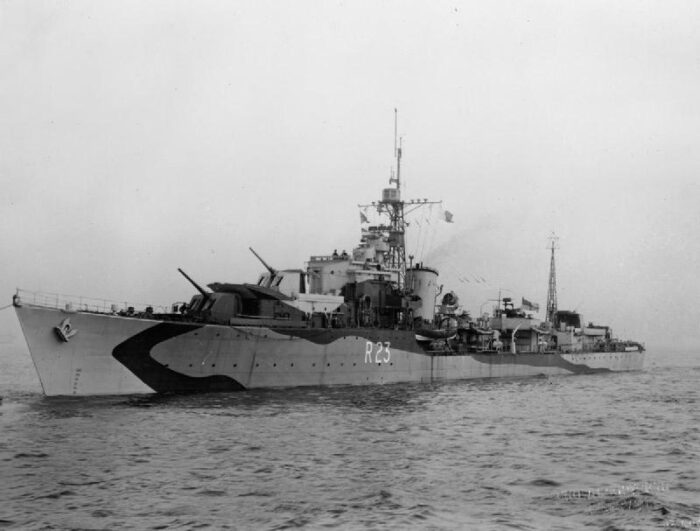
HMS Teazer in wartime, a far more martial apperance.
Austere it was, but they were far less capable and remained in service less longer than their forebears. The dualk purpose 4-in guns on “B” postion for example relied on a simple bathymetric director (STD) above the bridge, with a single Type 293 surface and air search radar with a target indicaiton radar on the masthead. The Torpedo tubes were presented as a guarantee of surface capabilities in case of war, as well as their minelaying capabilities for Orwell and Paladin, both absent on the Type 16. Their main asset were a twin Squids and handling room sited on the after superstructure.
Construction:
Tenacious was the prototype conversion despite her pennant F44 higher than many ships in class. She was converted first at the Royal Yard, Rosyth, in 1952 and abundantly tested. The remainder of conversions was done in 1952-56. It should be noted that some were converted as early as 1949, more precisions when looking at their careers. Their performances figures changed a bit (see later) and three (Teazer, Terpsichore and Tumult) had a new taller and narrow bridge.
Royal Dockyard, Rosyth: Tenacious (1952), Orwell (1952), Paladin (1954)
Harland & Wolff, Belfast: Petard (1953-1955)
Harland & Wolff, Liverpool & Gordon Alison Birkenhead: Tyrian (1951-53)
Mountstart Dry Docks, Cardiff: Teazer (1953–1954), Tuscan (1949-50)
Grayson Rollo, Birkenhead: Tumult (1949-50), Termagant (1952–1953)
J. I. Thornycroft, Woolston, Hampshire: Terpsichore (1953–1954)
Design of the class
Hull and general design
The O/P/T hull was unchanged, and so were most of the superstrcutures as precised above. As converted they displaced 1,800 long tons (1,800 t) standard and 2,300 long tons (2,300 t) full load, a bit lighter than the Type 14 conversions. They measured 362 ft 9 in (110.57 m) overall with a rounded poop and clipper bow, a beam of 37 ft 9 in (11.51 m) and a draught of 14 ft 6 in (4.42 m) for a nice destroyer hull ratio favouring great speeds. The original T class were 900 tonnes lighter at 1,710 long tons (1,737 t)-1,730 long tons standard nominal but in wartime they reached up to 2,545 long tons deep load. The lighter armament was counterebalanced after conversion by the sensors.
Powerplant
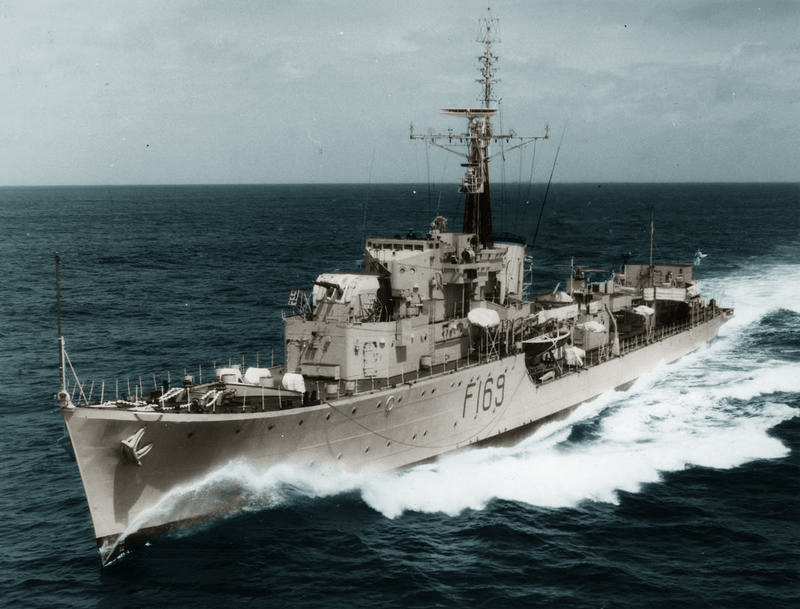
This was also unchanged, as they had originally being equipped with a coupled of Steam turbines (Thornycroft or Parsons type) fed by two large Admiralty 3-drum boilers delivering an output of 40,000 shp (30 Mw) for a top speed of still 32 knots (37 mph; 59 km/h) full load. Oriignally the T class were capable of 36.75 knots (42.29 mph; 68.06 km/h). This was still well enough to chase Soviet submarines.
Armament
4-in (102 mm) Mark 19 gun
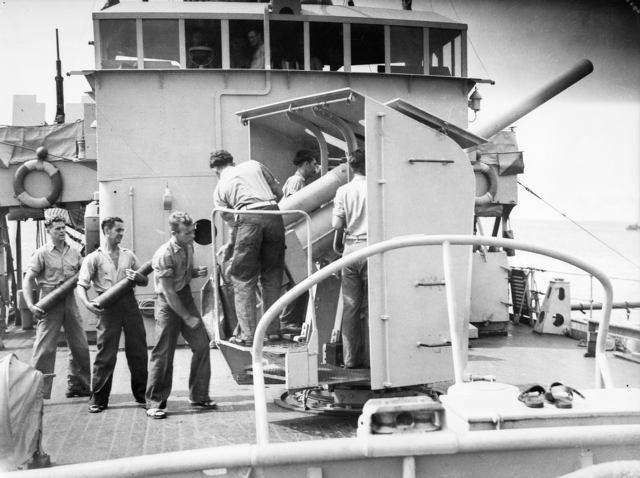
The Type 16 had a twin 4 inch gun on a Mounting Mark XIX was carried aft, controlled by the MRS-1 Close Range Blind-Fire director (CRBF).
Initially this was a 1938 low-velocity 40-calibre naval gun used to arm small warships such as Bathurst and Castle-class corvette ot River-class frigate, upgraded
compared to the Mark IX with a 35 pounds (16 kg) shell and a high-angle mounting giving some anti-aircraft capability or to fire starshells and illuminate a target at night (in WW2 a surfaced U-Boote sneeking in). Many of thse guns were now available from discarded WW2 legacy frigates and corvettes. They used an horizontal sliding-block to elevate -10° to +60° and fired that HE shell to a Muzzle velocity of 396 metres per second (1,300 ft/s) up to 8,870 metres (9,700 yd) at +40°.
Twin 40mm Bofors Mk.5
Behind the bridge was fitted a twin 40 mm Bofors gun on a “utility” Mounting Mark V. These were shielded mounts with relatively tall shield, much more than WW2 equivalents. The Bofors was still an efficient beast of burden of early AA protection, capable of a range of 7,160 m (23,490 ft), 120 round/min at high elevation angles (fed by clips) at a muzzle velocity of 850–880 m/s (2,800–2,900 ft/s).
In their later peacetime service these frigates ended as seagoing training ships, so their 40 mm guns were removed and in their place a large open bridge was added above the rounded face of the existing bridge.
Single 40mm Bofors Mk.9
In complement they had five single 40 mm Bofors gun Mk.9.
Squid ASWRL
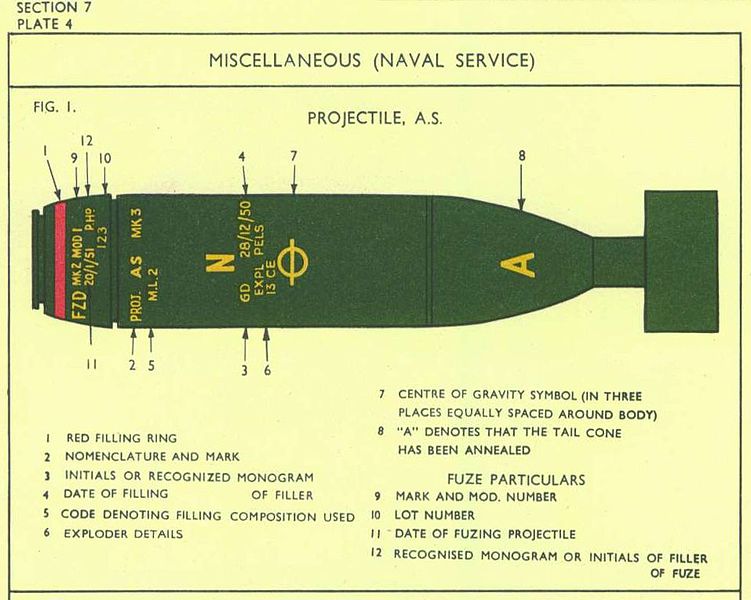
The SQUID MORTAR/BOMB – Mk IV was a British Late World War II ship-mounted anti-submarine mortar composed of three tubes with limited elevation, launching automatically preset depth charges, replacing the Hedgehog. The Tobruk class had it installed on the starboard aft quarter. It was still present on HMAS Anzac in 1968 and at the end of her service, despite the fact it had been long replaced by the Limbo back in UK.
In brief, the Squid launched 390 pounds (177 kg) DCs topped with a 207-pound (94 kg) minol charge which had a sink rate of 43.5 ft/s (13.3 m/s), clockwork time fuse with last moment updates and max depth of 900 feet (270 m), creating a triangle pattern c40 yards (37 m) wide, 275 yards (251 m) ahead of the ship.
Torpedo Tubes
These frigates kept a “reserve antiship capability” that might be useful in wartime, along with Mark 9 torpedoes. More on the latter when dealing with the T class destroyers in the future. An extra weight that was also criticized as being useless for their role and better off with a second ASW system.
Assertion and limitations
Like the Type 14 full conversions, they had no helicopter nor ASW torpedoes, not even standard depht charge racks and throwers. They were obsolete already in 1960 and their cheap converison made them far less capable thajn the Type 14. But they fulfilled their mission as fast interim ASW escorts for far less than a brand new ASW frigate. However, further cost cuttings mean most spent their post-conversion time into various reserves, from the regular reserve to the “operational reserve” for a few with a crew ready to bring them in full order at a moment notice. This conversion however added a further ten years on the RN list, for a total of 20+ years or useful career. They were however stricken and scrapped earlier than most Type 14 and were far less active that the latter. To summup, they were “reserve cheap ASW frigates” that would have been activated in wartime.
Sensors
The new sensor suite comprised a Type 293Q surface/air search radar, Type 974 navigation sonar and a sonar outfit comprising the Type 146B search, Type 147P depth finder, Type 162 target classification and Type 174 Squid control.
Type 293Q target indication Radar: Outfit ANS, PP 500kw, Frq 2,997 Mhz, Wlgt 100mm (1945).
Type 277Q surface search Radar: CV56 magnetrons/70 kW, new waveguide system (1942).
Type 974 navigation Radar: X-Band, FRQ 9 405 MHz, PRF 1000 Hz, pwt 0.14/0.26 µs, bwt 1.6°, 24 rpm, PP 7 kW range 25 NM (≙ 46 km) at 2% accuracy.
Type 262 fire control on director CRBF: Centimetric FC set for 40 mm Bofors, fitted to Close Range Blind Fire (CRBF) director and STAAG weapon mount. Dish antenna spun off-centre at high speed to produce scanning cone, target lock and blind fire possible.
Type 1010 Cossor Mark 10 IFF: Friend of Foe identification L-band antenna, interrogates one modes 1,2,3/A a transponder.
Type 174 search Sonar: Narrow beam attack sonar usually associated with Mortar MK 10.
Type 162 Cockwhafer target classification sonar: Side-looking and bottom-scanning shipboard sonar.
Type 170 attack sonar: Hull-mounted, high-frequency “searchlight” sonar with a range of 8,200 feet (2,500 meters).

Conway’s depiction of the Type 15 as completed 1952-54
⚙ Type 16 specifications |
|
| Displacement | 1,800 tonnes standard, 2,300 tonnes full load |
| Dimensions | 362 ft 9 in x 37 ft 9 in x 14 ft 6 in (110.57 x 11.51 x 4.42 m) |
| Propulsion | 2 shafts GST, 2× Admiralty 3-drum boilers 40,000 shp (30 MW) |
| Speed | 32 knots (37 km/h; 59 mph) |
| Range | As T class |
| Armament | 1×2 4 in (102 mm) Mark 19, 7x 40mm Bofors Mk.5, 2× Squid/Limbo Mark 10 ASWRL, 1×5 21-in TTs |
| Sensors | Type 293Q TIR, 974 NR, 1010 Cossor Mark 10 IFF, Sonar suite Type 146B/147/162/174 |
| Crew | 175 |
Career of the Type 16 class
Note: There are very few open source photos of these frigates under Type 16 conversion. Hope more photos will be included inder this licence in the future.
 HMS Orwell F98
HMS Orwell F98
HMS Orwell, sole converted O class of the Type 16 was laid down on at Thornycroft, Woolston on 16 May 1940, launched on 2 April 1942 and completed on 7 October 1942. She was converted at the Royal Dockyard, Rosyth, in 1952. She joined the Plymouth local flotilla. In June 1953 she was in the Fleet Review for the Coronation of Queen Elizabeth II. Between 1953 and 1958 she was Captain (Destroyers) at Plymouth and from 29 July 1956, she answered the distressed signalled of the sail training ship Moyana in the English Channel, as duty destroyer at Plymouth, and was vectored in after being spotted by an RAF Shackleton and the merchant ship Clan Maclean went and took off her crew. Orwell then arrived and took Moyana under tow but she foundered. On 28 November 1958, she collided with the survey ship Vidal.] She waswas placed in reserve by February 1959 at Rosyth and underwent new refit, remaining in reserve until 1961. Until 1963 she was relocated at the Portsmouth reserved, and then stricken, sold to John Cashmore Ltd, BU started on 28 June 1965.
 HMS Paladin F169
HMS Paladin F169
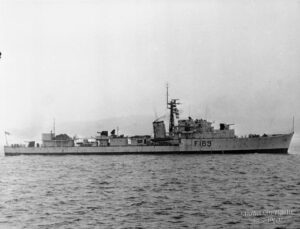 First P class converted to Type 16 frigate, HMS Paladin was laid down at J Brown, Clydebank on 22 July 1940, launched on 11 June 1941 and completed on 12 December 1941. She was converted at Royal Dockyard, Rosyth, in 1954. After completion she was straight in reserve, until converted to a minelayer in 1957: Remaining TT and three Bofors removed. 30 mines carried on rails, displacement now 1,800 long tons (1,829 t) standardn 2,300 long tons (2,337 t) full load. She was recommissioned on 10 January 1958 with the Nore Local Squadron and tasked of fishery protection patrol near Iceland (cod wars). She escorted the yacht Britannia carrying the Queen and the Duke of Edinburgh to the Netherlands in March 1958. In May she fired a 21 gun salute when outside French territorial waters, taking back escort from the French destroyer Jauréguiberry. She stricken and sold on 1961, sent to Dunston, Tyne and Wear for BU from 22 October 1962.
First P class converted to Type 16 frigate, HMS Paladin was laid down at J Brown, Clydebank on 22 July 1940, launched on 11 June 1941 and completed on 12 December 1941. She was converted at Royal Dockyard, Rosyth, in 1954. After completion she was straight in reserve, until converted to a minelayer in 1957: Remaining TT and three Bofors removed. 30 mines carried on rails, displacement now 1,800 long tons (1,829 t) standardn 2,300 long tons (2,337 t) full load. She was recommissioned on 10 January 1958 with the Nore Local Squadron and tasked of fishery protection patrol near Iceland (cod wars). She escorted the yacht Britannia carrying the Queen and the Duke of Edinburgh to the Netherlands in March 1958. In May she fired a 21 gun salute when outside French territorial waters, taking back escort from the French destroyer Jauréguiberry. She stricken and sold on 1961, sent to Dunston, Tyne and Wear for BU from 22 October 1962.
 HMS Petard F56
HMS Petard F56
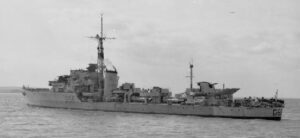 Second and last P class converted as Type 16 Frigate, Petard was laid down at Vickers Armstrong, Tyne on 26 December 1939, launched on 27 March 1941 and completed on 14 June 1942. She was converted at Harland & Wolff, Belfast, in 1953–1955. She was mothballed in Southampton, towed to Devonport and laid up until 1960 after conversion. She was re-commissioned that year for Home Fleet duties notably at Sea Training Ship for Junior Seamen Trainees, attached to HMS Ganges establishment. She was placed on the disposal list by May 1964 and udner 1965–1966 Naval Estimates was stripped at Devonport dockyard on 31 January 1966, sold and BU in 1967 at P. W. McLellan at Bo’ness.
Second and last P class converted as Type 16 Frigate, Petard was laid down at Vickers Armstrong, Tyne on 26 December 1939, launched on 27 March 1941 and completed on 14 June 1942. She was converted at Harland & Wolff, Belfast, in 1953–1955. She was mothballed in Southampton, towed to Devonport and laid up until 1960 after conversion. She was re-commissioned that year for Home Fleet duties notably at Sea Training Ship for Junior Seamen Trainees, attached to HMS Ganges establishment. She was placed on the disposal list by May 1964 and udner 1965–1966 Naval Estimates was stripped at Devonport dockyard on 31 January 1966, sold and BU in 1967 at P. W. McLellan at Bo’ness.
 HMS Teazer F23
HMS Teazer F23
HMS Teazer had been laid down at Cammell Laird on 20 October 1940, launched on 7 January 1943 and completed on 13 September 1943. She was converted at Mountstart Dry Docks, Cardiff about then years later between 1953 and 1954. In January 1959, she replaced Grenville in the 2nd Training Squadron. After final decommission, HMS Teazer was placed on the disposal list by September 1961 and sold to Arnott Young, Dalmuir from 7 August 1965.
 HMS Tenacious F44
HMS Tenacious F44
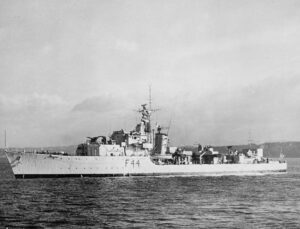 Tenacious was laid down at Cammell Lairdon 3 December 1941, launched on 24 March 1943 and completed on 30 October 1943 and converted at Royal Dockyard, Rosyth in 1951–1952. On 8 May 1952, she ran aground in the River Foyle (Northern Ireland). In 1953, she took part in the Fleet Review (Coronation of Queen Elizabeth II). In 1954 she was placed in reserve at Rosyth. In 1956 she was placed into reserve at Barrow. In September 1963, she was towed to Plymouth, decommissioned and stricken, and sold for scrapping in 1965, which was done at Troon from 29 June.
Tenacious was laid down at Cammell Lairdon 3 December 1941, launched on 24 March 1943 and completed on 30 October 1943 and converted at Royal Dockyard, Rosyth in 1951–1952. On 8 May 1952, she ran aground in the River Foyle (Northern Ireland). In 1953, she took part in the Fleet Review (Coronation of Queen Elizabeth II). In 1954 she was placed in reserve at Rosyth. In 1956 she was placed into reserve at Barrow. In September 1963, she was towed to Plymouth, decommissioned and stricken, and sold for scrapping in 1965, which was done at Troon from 29 June.
 HMS Termagant F189
HMS Termagant F189
Termagant was laid down at Denny in Dumbarton on 25 November 1941, launched on 22 March 1943 and completed on 30 October 1943. She was converted as a Type 16 Frigate at Grayson Rollo, Birkenhead, in 1952–1953. On 4 March 1953, there was an oil fire in her engine room, quickly mastered and only causing paintwork damage. On 12 March she had a pipe failure and her engine room was flooded up to 5 ft (1.5 m) od weawater. The crew needed three hours to pump it out after fixing the pipe. She was recommissioned at last on 28 April 1953, with the new pennant F189. She then joined the 3rd Submarine Flotilla at Rothesay as target ship and took part in the Fleet Review for the Coronation of Queen Elizabeth II. She was replaced in reserve from 26 September 1957 at Devonport, her duties retook by a brand new Type 14 frigate, HMS Blackwood, in the 3rd Submarine Flotilla. She was just re-commissioning in 1958 for trials and returned. After a long reserve period at Lisahally in 1961-1965 she was stricken, sold for scrap to Arnott Young in Dalmuir, BU from 5 November 1965.
 HMS Terpsichore F19
HMS Terpsichore F19
Terpsichore was laid down at Denny in Dumbarton on 25 November 1941, launched on 17 June 1943 and completed on 20 January 1944. She was converted at J. I. Thornycroft in Woolston, Hampshire, in 1953–1954. In 1955 she was in reserve at Devonport, under refit until December 1957. In 1960-1966 she was moved to the reserve at Lisahally. She was strocke, sold for scrap at Troon on 17 May 1966.
 HMS Tumult F121
HMS Tumult F121
HMS Tumult was laid down at J Brown, Clydebank on 16 November 1941, launched 9 November 1941 and complted on 2 April 1943. She was converted the first as a Type 16 at Grayson Rollo in Birkenhead, 1949–1950. Despite of this class is still called “tenacious” in official records. In November 1956 she was assigned to the 2nd Training Squadron at Portsmouth. Between December 1957 and December 1960 she was part of the Chatham reserve. From December 1960 until October 1965 she entered the Rosyth reserve. She was stricken and sold for scrap to Arnott Young at Dalmuir from 25 October 1965.
 HMS Tuscan F156
HMS Tuscan F156
Tuscan was laid down at Swan Hunter in Wallsend on 9 September 1941, launched on 28 May 1942 and completed 11 March 1943. She was converted second, at Mountstart Dry Docks, Cardiff in 1949–1950. In 1953, she was retained in the Devonport Reserve. In 1954 she was moved to the Portsmouth Reserve. In 1960, she was back to the Chatham reserve. In 1961-1963 was sent again to the Portsmouth Operational Reserve with a higher readiness status (Cuban missile crisis). She was stricken and sold to McLellan, BU at Bo’ness from 26 March 1966.
 HMS Tyrian F67
HMS Tyrian F67
Tyrian was laid down at Swan Hunter, Wallsend on 15 October 1941, launched on 27 July 1942 and completed on 8 April 1943. After her wartime career she was converted at Harland & Wolff, Liverpool & Gordon Alison in Birkenhead 1951–1953. From August 1952 to 1956 she was part of the 2nd Training Squadron, Portland. In 1953, she took part in the Fleet Review celebrating the Coronation of Queen Elizabeth II. On 29 September 1953, she ran aground on Haisborough Sands, SE of Cromer and all efforts were fruitful as she was refloated later that day.
In November 1956 she entered the reserve at Chatham. In 1957-1965 she was moved to the Lisahally reserve. She was sold for scrap at Troon from 9 March 1965.
Read More/Src
Books
Conway’s all the world’s fighting ships 1947-95.
Colledge, J. J.; Wardlow, Ben & Bush, Steve (2020). Ships of the Royal Navy. Barnsley, UK: Seaforth Publishing.
“Royal Navy Frigates 1945-1983” Leo Marriott, Ian Allan, 1983.
Links
en.wikipedia.org Type_16_frigate
profile plans rmg.co.uk/
on worldnavalships.com
navweaps.com tech-106.php
Model Kits
None found

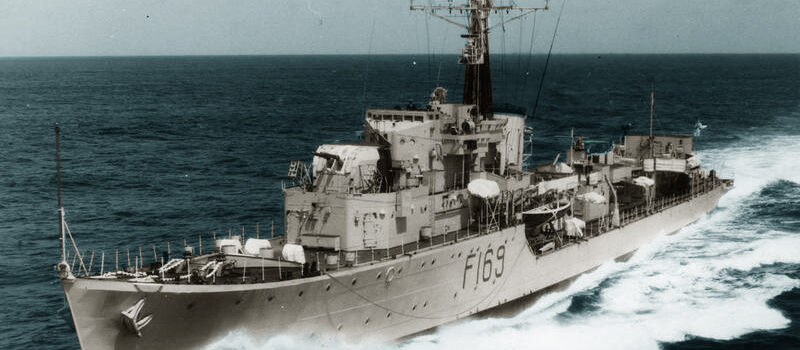
 Latest Facebook Entry -
Latest Facebook Entry -  X(Tweeter) Naval Encyclopedia's deck archive
X(Tweeter) Naval Encyclopedia's deck archive Instagram (@navalencyc)
Instagram (@navalencyc)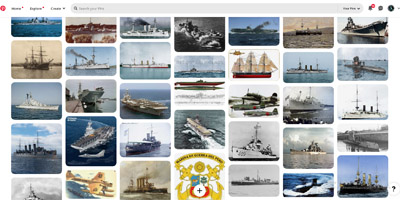

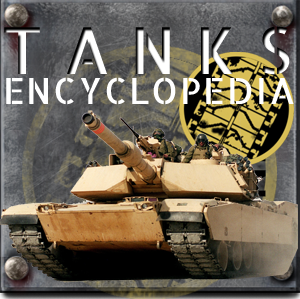
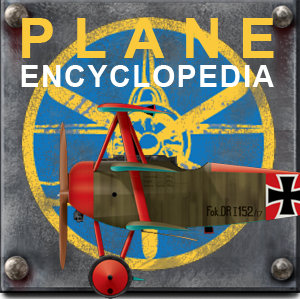
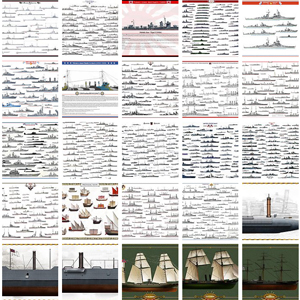

 French Navy
French Navy Royal Navy
Royal Navy Russian Navy
Russian Navy Armada Espanola
Armada Espanola Austrian Navy
Austrian Navy K.u.K. Kriegsmarine
K.u.K. Kriegsmarine Dansk Marine
Dansk Marine Nautiko Hellenon
Nautiko Hellenon Koninklije Marine 1870
Koninklije Marine 1870 Marinha do Brasil
Marinha do Brasil Osmanlı Donanması
Osmanlı Donanması Marina Do Peru
Marina Do Peru Marinha do Portugal
Marinha do Portugal Regia Marina 1870
Regia Marina 1870 Nihhon Kaigun 1870
Nihhon Kaigun 1870 Preußische Marine 1870
Preußische Marine 1870 Russkiy Flot 1870
Russkiy Flot 1870 Svenska marinen
Svenska marinen Søværnet
Søværnet Union Navy
Union Navy Confederate Navy
Confederate Navy Armada de Argentina
Armada de Argentina Imperial Chinese Navy
Imperial Chinese Navy Marinha do Portugal
Marinha do Portugal Mexico
Mexico Kaiserliche Marine
Kaiserliche Marine 1898 US Navy
1898 US Navy Sovietskiy Flot
Sovietskiy Flot Royal Canadian Navy
Royal Canadian Navy Royal Australian Navy
Royal Australian Navy RNZN Fleet
RNZN Fleet Chinese Navy 1937
Chinese Navy 1937 Kriegsmarine
Kriegsmarine Chilean Navy
Chilean Navy Danish Navy
Danish Navy Finnish Navy
Finnish Navy Hellenic Navy
Hellenic Navy Polish Navy
Polish Navy Romanian Navy
Romanian Navy Turkish Navy
Turkish Navy Royal Yugoslav Navy
Royal Yugoslav Navy Royal Thai Navy
Royal Thai Navy Minor Navies
Minor Navies Albania
Albania Austria
Austria Belgium
Belgium Columbia
Columbia Costa Rica
Costa Rica Cuba
Cuba Czechoslovakia
Czechoslovakia Dominican Republic
Dominican Republic Haiti
Haiti Hungary
Hungary Honduras
Honduras Estonia
Estonia Iceland
Iceland Eire
Eire Equador
Equador Iran
Iran Iraq
Iraq Latvia
Latvia Liberia
Liberia Lithuania
Lithuania Mandchukuo
Mandchukuo Morocco
Morocco Nicaragua
Nicaragua Persia
Persia San Salvador
San Salvador Sarawak
Sarawak Uruguay
Uruguay Venezuela
Venezuela Zanzibar
Zanzibar Warsaw Pact Navies
Warsaw Pact Navies Bulgaria
Bulgaria Hungary
Hungary

 Bundesmarine
Bundesmarine Dutch Navy
Dutch Navy Hellenic Navy
Hellenic Navy Marina Militare
Marina Militare Yugoslav Navy
Yugoslav Navy Chinese Navy
Chinese Navy Indian Navy
Indian Navy Indonesian Navy
Indonesian Navy JMSDF
JMSDF North Korean Navy
North Korean Navy Pakistani Navy
Pakistani Navy Philippines Navy
Philippines Navy ROKN
ROKN Rep. of Singapore Navy
Rep. of Singapore Navy Taiwanese Navy
Taiwanese Navy IDF Navy
IDF Navy Saudi Navy
Saudi Navy Royal New Zealand Navy
Royal New Zealand Navy Egyptian Navy
Egyptian Navy South African Navy
South African Navy






























 Ukrainian Navy
Ukrainian Navy dbodesign
dbodesign